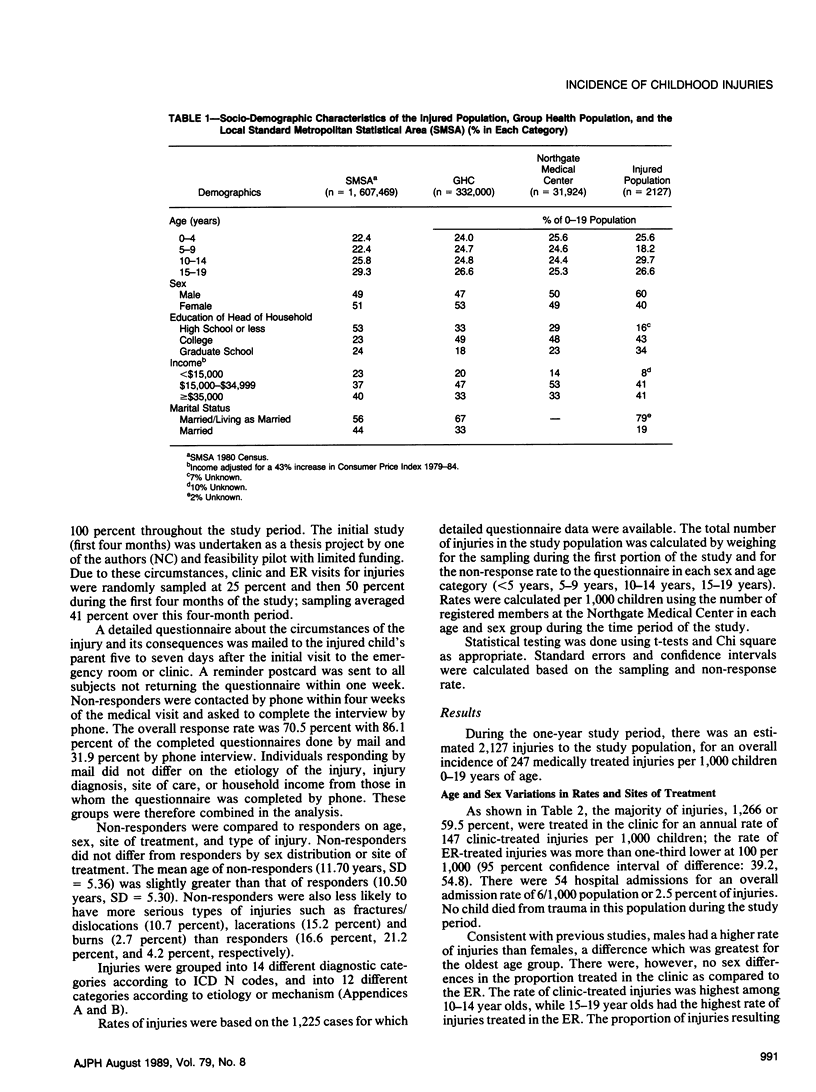Abstract
We report a prospective study of medically treated unintentional injuries ascertained in an HMO population of children and adolescents 19 years of age and younger over a one-year period. The overall rate of medically treated injuries was 247 per 1,000, 147/1,000 for those treated in the clinic, and 100/1,000 for those treated in the emergency room (ER). Overall, 2.5 percent of patients were hospitalized. The highest rates of injury were for falls (60 per 1,000), recreational activities (57 per 1,000) and competitive sports (49 per 1,000). The site of care varied little by injury diagnosis or etiology, with the exception that sprains/strains, fractures, and injuries due to play and sports were more commonly treated in the clinic. The impact of trauma on activity was considerable, with 55.9 percent of injuries resulting in restricted activity, 10.6 percent in greater than or equal to 2 days of school missed, and 6.7 percent in greater than or equal to 2 days spent in bed.
Full text
PDF




Selected References
These references are in PubMed. This may not be the complete list of references from this article.
- Barancik J. I., Chatterjee B. F., Greene Y. C., Michenzi E. M., Fife D. Northeastern Ohio trauma study: I. Magnitude of the problem. Am J Public Health. 1983 Jul;73(7):746–751. doi: 10.2105/ajph.73.7.746. [DOI] [PMC free article] [PubMed] [Google Scholar]
- Gallagher S. S., Finison K., Guyer B., Goodenough S. The incidence of injuries among 87,000 Massachusetts children and adolescents: results of the 1980-81 Statewide Childhood Injury Prevention Program Surveillance System. Am J Public Health. 1984 Dec;74(12):1340–1347. doi: 10.2105/ajph.74.12.1340. [DOI] [PMC free article] [PubMed] [Google Scholar]
- Klauber M. R., Barrett-Connor E., Hofstetter C. R., Micik S. H. A population-based study of nonfatal childhood injuries. Prev Med. 1986 Mar;15(2):139–149. doi: 10.1016/0091-7435(86)90084-8. [DOI] [PubMed] [Google Scholar]
- MacKay A., Halpern J., McLoughlin E., Locke J., Crawford J. D. A comparison of age-specific burn injury rates in five Massachusetts communities. Am J Public Health. 1979 Nov;69(11):1146–1150. doi: 10.2105/ajph.69.11.1146. [DOI] [PMC free article] [PubMed] [Google Scholar]
- Manheimer D. I., Dewey J., Mellinger G. D., Corsa L., Jr 50,000 child-years of accidental injuries. Public Health Rep. 1966 Jun;81(6):519–533. [PMC free article] [PubMed] [Google Scholar]
- Nersesian W. S., Petit M. R., Shaper R., Lemieux D., Naor E. Childhood death and poverty: a study of all childhood deaths in Maine, 1976 to 1980. Pediatrics. 1985 Jan;75(1):41–50. [PubMed] [Google Scholar]
- Rivara F. P., Barber M. Demographic analysis of childhood pedestrian injuries. Pediatrics. 1985 Sep;76(3):375–381. [PubMed] [Google Scholar]
- Runyan C. W., Kotch J. B., Margolis L. H., Buescher P. A. Childhood injuries in North Carolina: a statewide analysis of hospitalizations and deaths. Am J Public Health. 1985 Dec;75(12):1429–1432. doi: 10.2105/ajph.75.12.1429. [DOI] [PMC free article] [PubMed] [Google Scholar]
- Schor E. L. Unintentional injuries. Patterns within families. Am J Dis Child. 1987 Dec;141(12):1280–1284. doi: 10.1001/archpedi.1987.04460120042030. [DOI] [PubMed] [Google Scholar]


